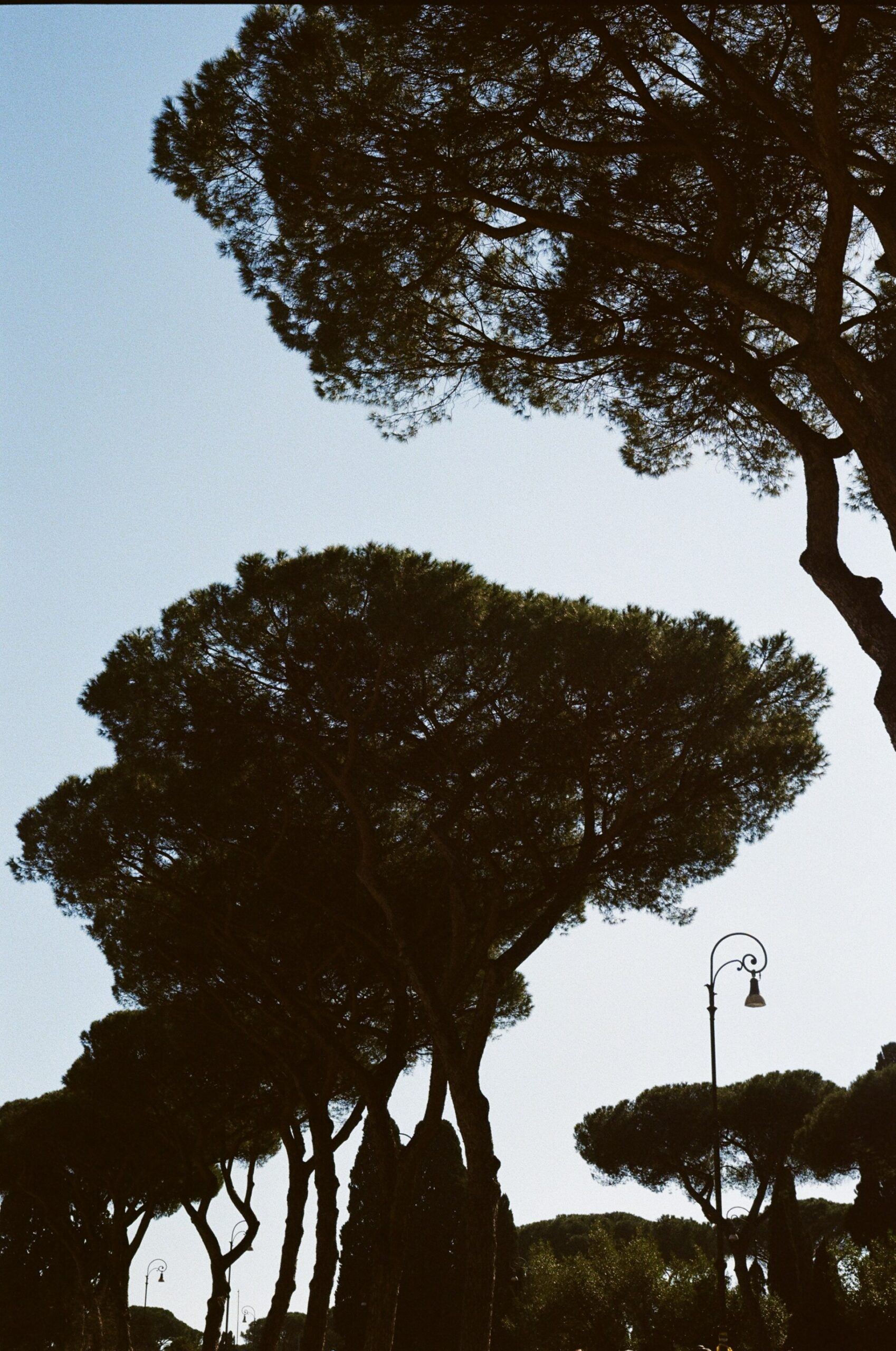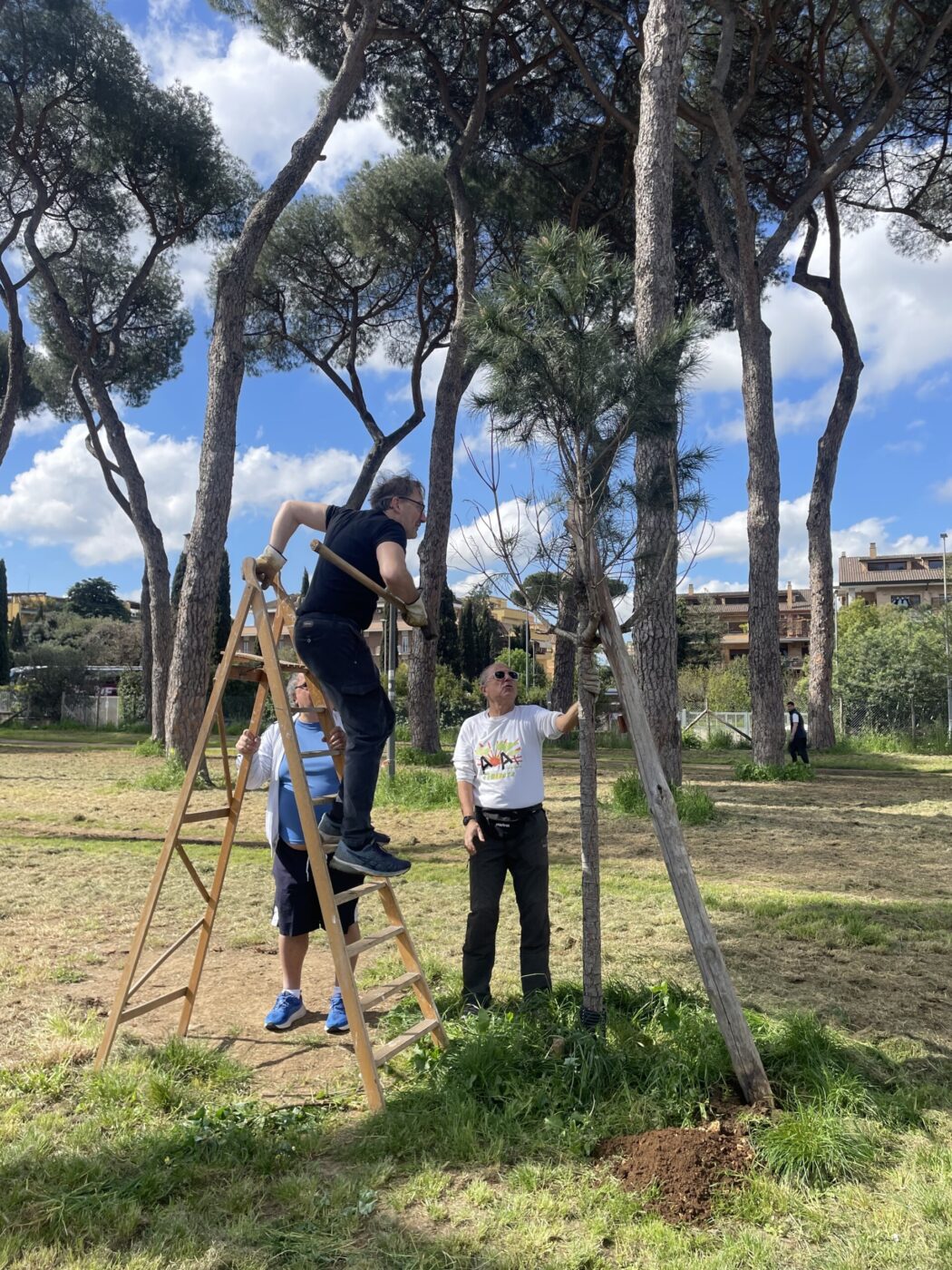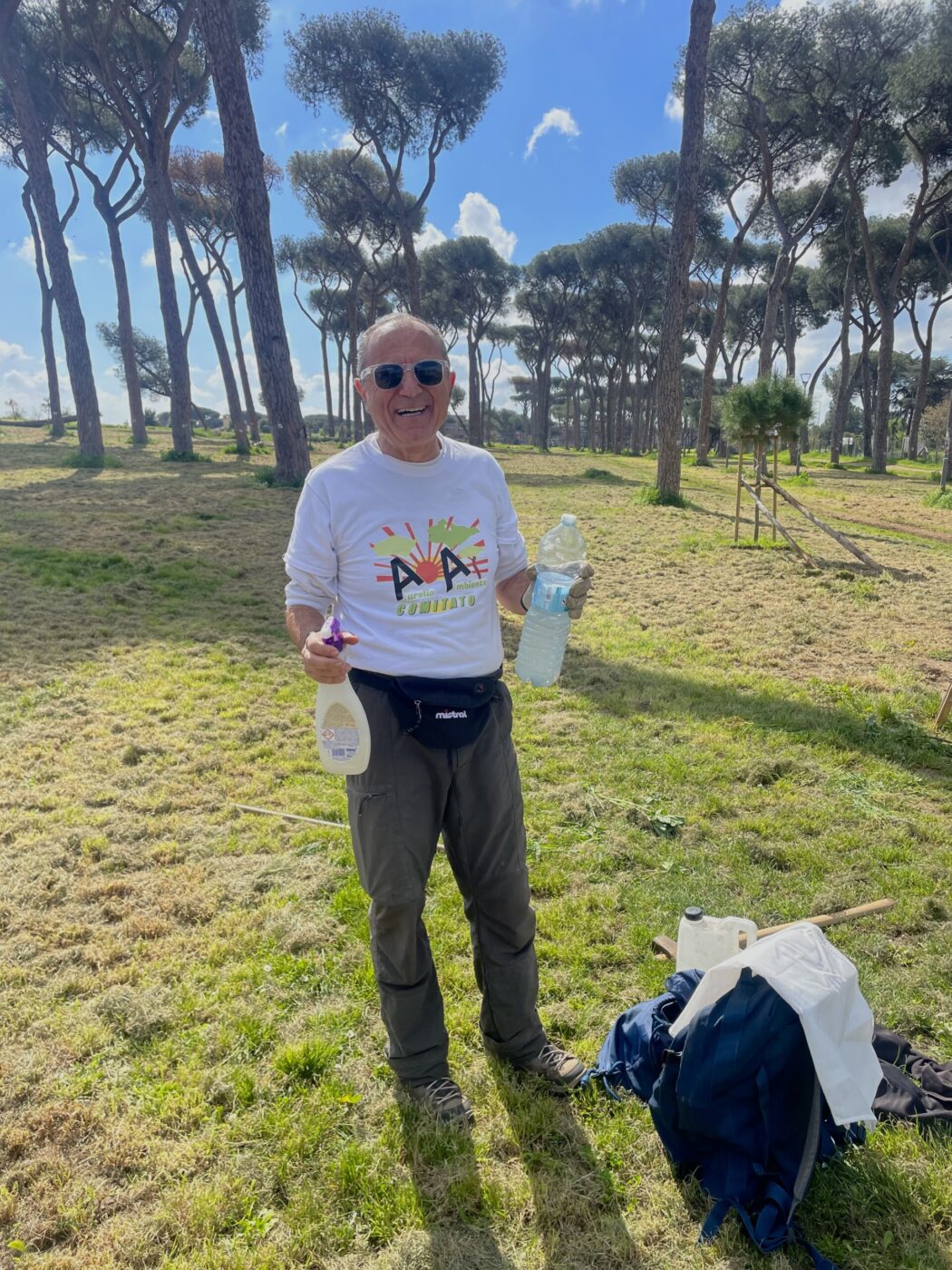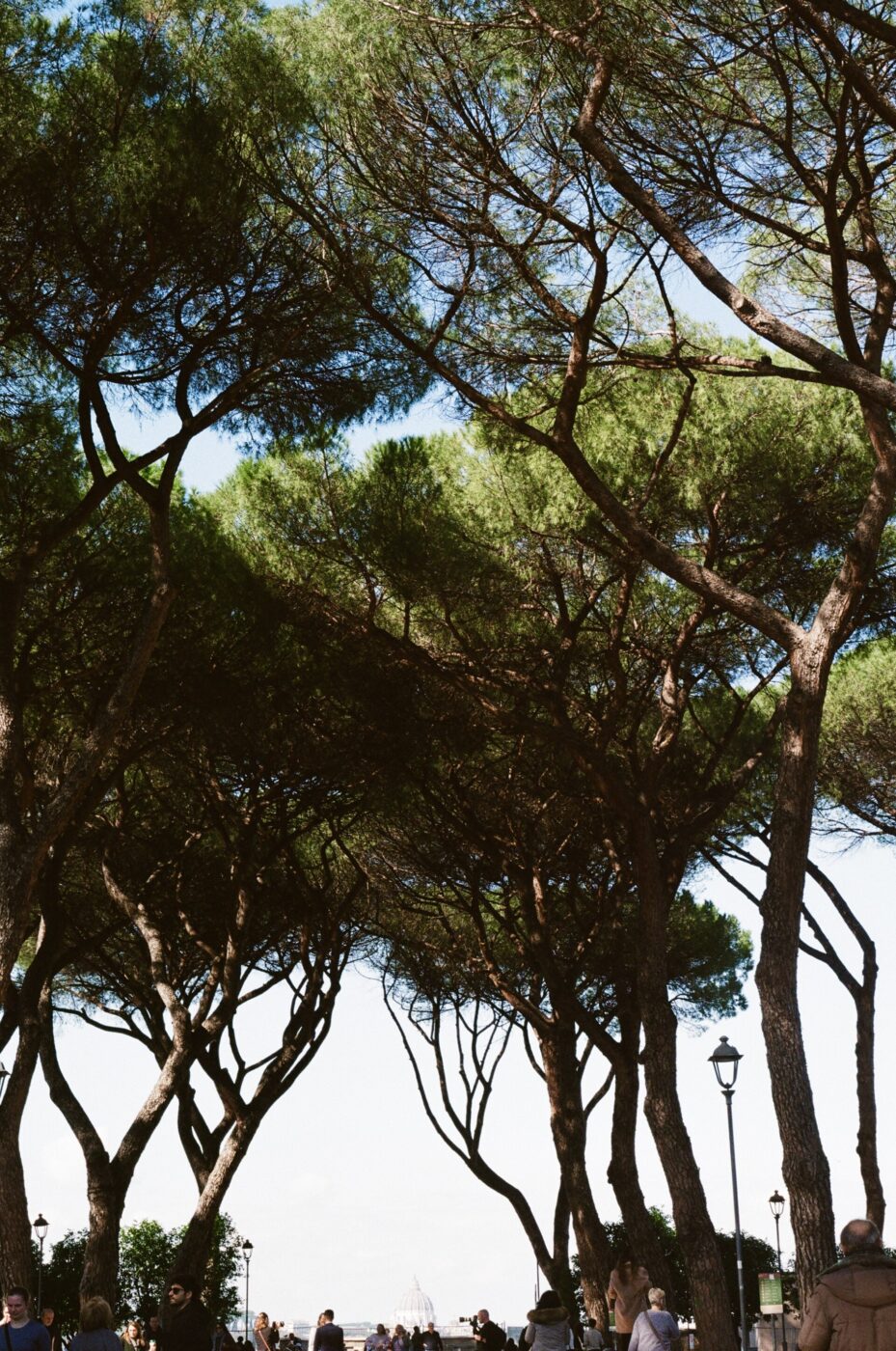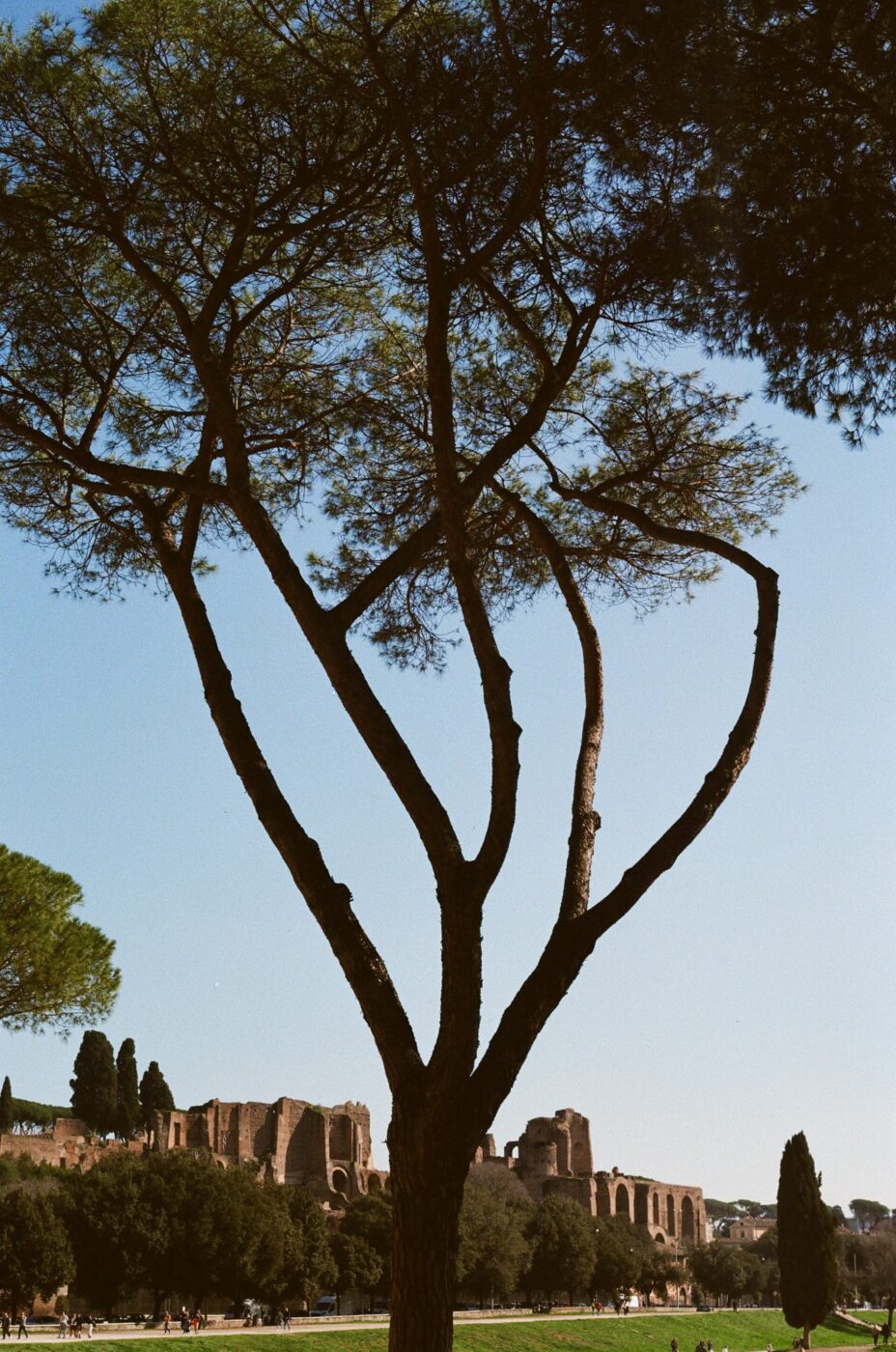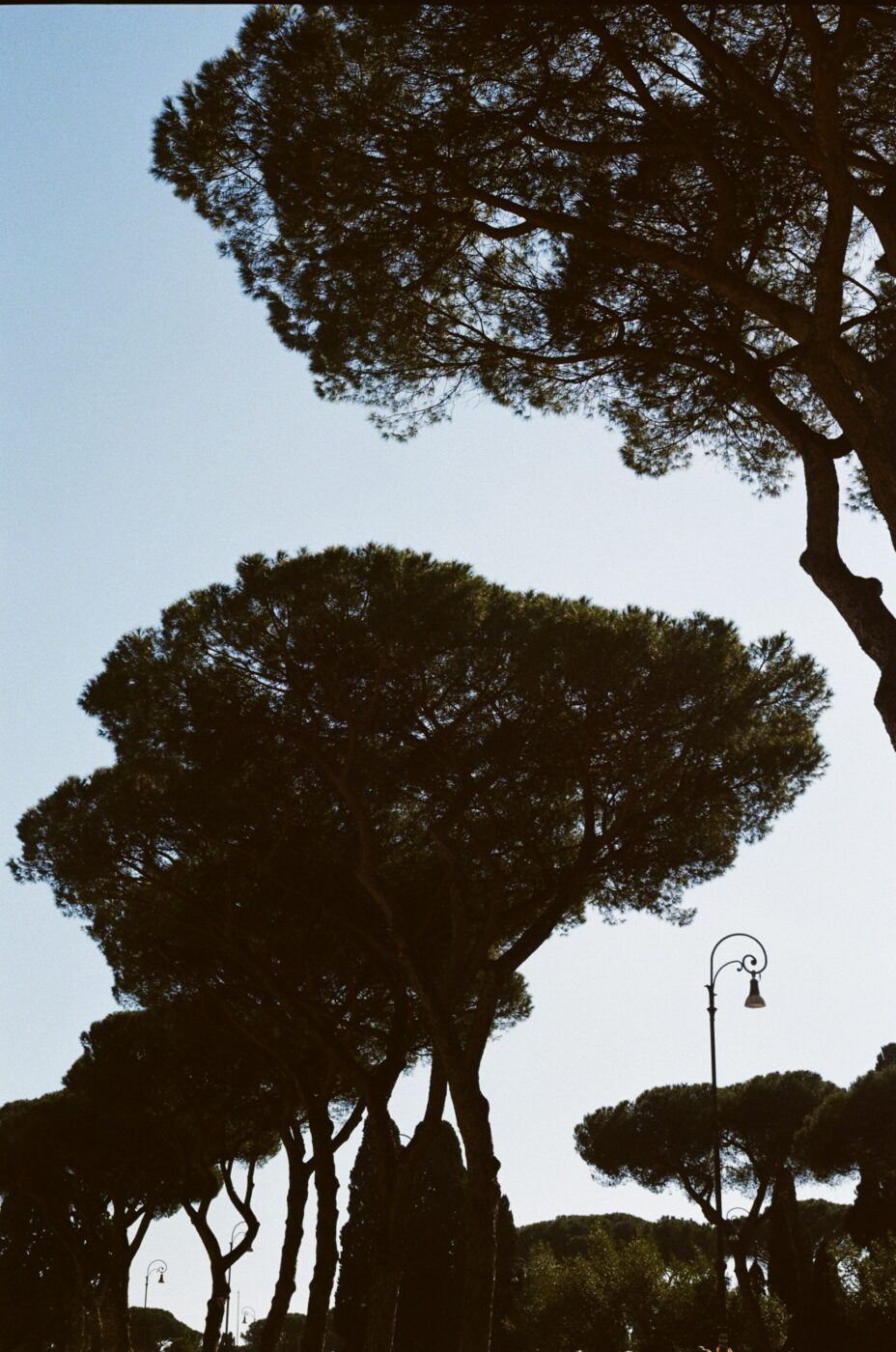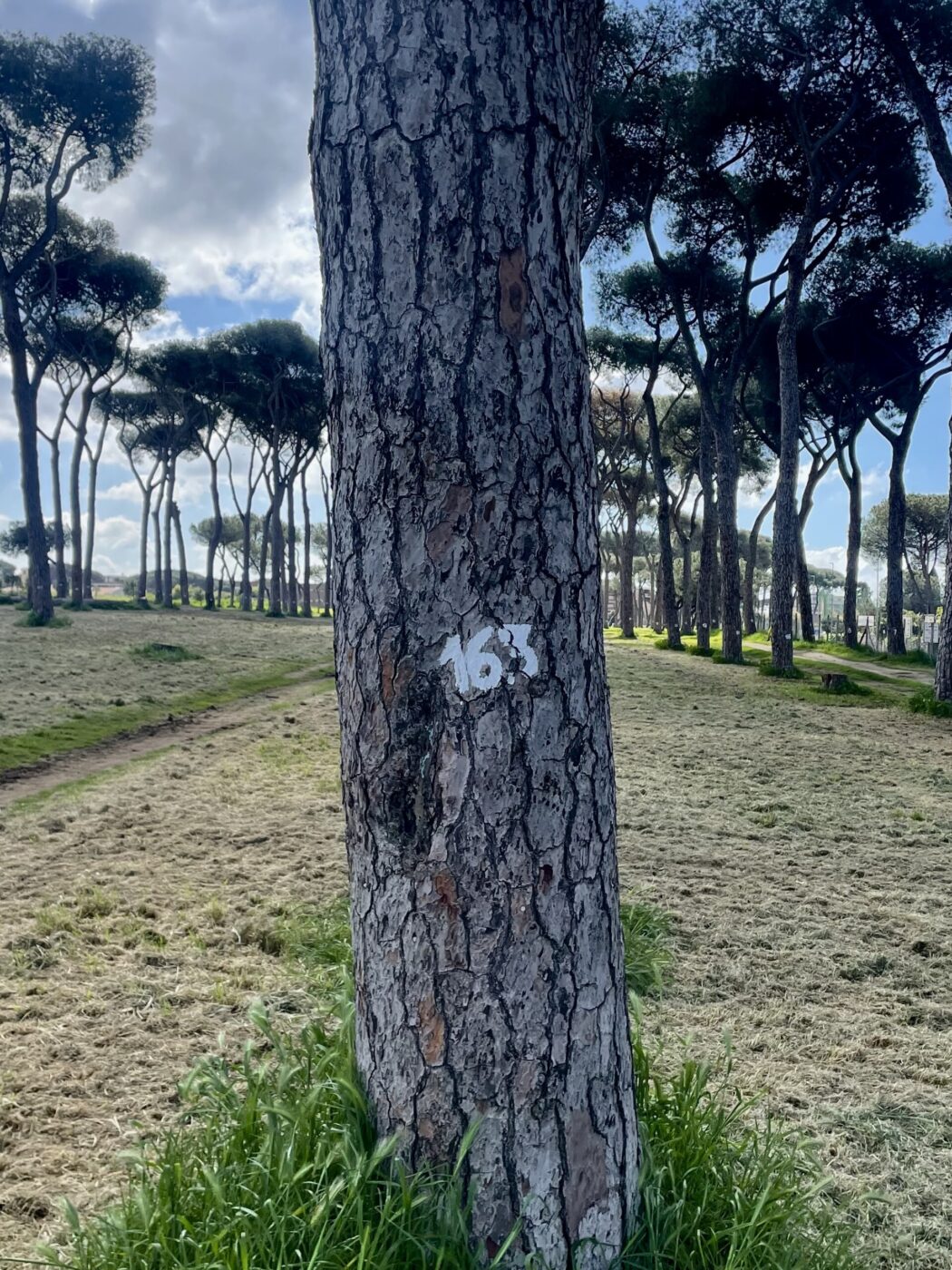Like many of Rome’s public parks, the entrance to Pineta Sacchetti exists just on the limit between the urban and the natural—only minutes from the bustling core near Rome’s Cornelia metro stop, you suddenly find yourself in a vast plain dotted with the city’s distinctive pine trees, their curling trunks and outstretched leaves imparting a fragility that only adds to their beauty.
Today, unlike most days, I have not come to simply gawk at Rome’s most characteristic arboreal feature. I have arrived in this green expanse looking for someone, or someones, to be more exact—Franco Quaranta, a former business economics teacher at a technical institute in Rome, and the president of the volunteers that make up the Comitato Aurelio per l’Ambiente, dedicated to preserving this very park. I call Quaranta to try to determine their whereabouts, and he gives me a simple instruction: “Look for the white t-shirts.”
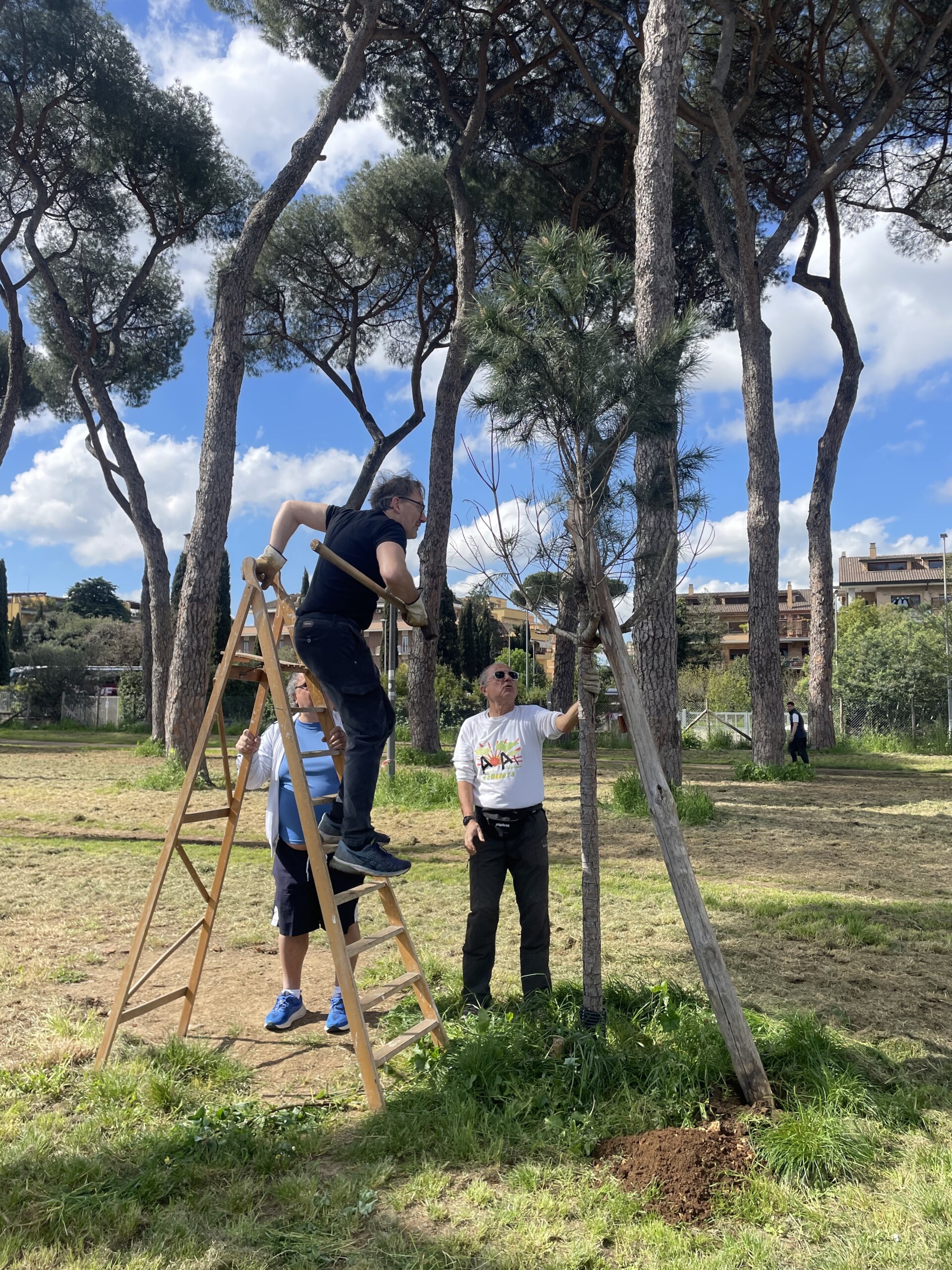
The Comitato Aurelio per l’Ambiente tending to a baby pine; Photo by Elizabeth Djinis
Sure enough, I don’t have to go far before I see a group of three men standing over a tree. Quaranta has come armed with a large plastic bottle of water and a spray bottle, which looks like cleaning liquid but is actually filled with a special concoction: two tablespoons of sapone di Marsiglia, two cloves of garlic, cut in half, and almost 1.5 liters of water. About once a week, volunteers come to this pine forest in the middle of Rome to hand-clean each of its almost 60 newly-planted pines with this naturally-made “infusion,” as Quaranta calls it.
Every week, I look at Quaranta, raising my eyes, both impressed and, perhaps, skeptical.
“I come a little more often, but obviously, you have your personal life, obligations—sometimes, I even put aside my own things to do this,” he says. “But there’s a limit, you know?”
But Quaranta is choosing to spend his retirement hand-washing the pine trees of Pineta Sacchetti with a spray bottle. While even he may have a limit, he also has a clear sense of purpose and, perhaps more than that, urgency. The baby pines spread throughout the park are maybe double the size of Quaranta himself, but the space, the estate of the noble Florentine Sacchetti family until 1861, when it was sold to Prince Alessandro Torlonia, is still home to pines planted 80 to 90 years ago. These pines once filled the park with abandon, but now, thanks to a threatening parasite and what activists say is the city’s management, the tree population is dwindling.
In 2020, Quaranta said, by his count, Pineta Sacchetti had roughly 395 nearly century-old pines. Now, the park only has about 260, half of the roughly 520 trees there were a decade ago. Volunteers from a variety of groups have done what they can by planting more than 30 new trees since 2015. The municipality has planted another 28, according to Quaranta. He points to the very first pine that was planted by volunteers in 2015, transferred into the ground from a pot—its trunk and cones spread boisterously into the sky.
This would seem like a type of success story, but the problem, Quaranta says, is that the pines are still in danger: “These treatments are only working up to a certain point.”

The umbrella-like canopy of the Italian stone pine is perhaps as much a symbol of the city as the Colosseum or the Pantheon. This hearkens back even to Ancient Rome—the iconic frescoes from the Villa of Livia, Emperor Augustus’ wife, offer one of our first continuous depictions of a garden and include the Pinus Pinea species. They date from around 30 to 20 B.C.E.
Today, experts estimate that more than 60,000 pines are scattered across Rome’s landscape, per the European Forest Institute. As of 2016, the European Atlas of Forest Tree Species defined pinus pinea as “rarely attacked by pests and diseases,” noting that forest fires were the “major threat.” It’s only in recent years that the Italian stone pine has had to combat a real external and invasive foe: the pine tortoise scale, known in Italian as the cocciniglia tartaruga and by its scientific name as the Toumeyella parvicornis.
The first signs of the North-American-hailing parasite in Italy came in 2014 in the Campania region, according to Sabrina Alfonsi, Rome’s Council Member for Agriculture, Environment and Waste Management. It took four years for the first cases to be recorded in Rome, in the Mostacciano neighborhood.
“In Italy, with our pine forests of Pinus Pinea, the [cocciniglia] has found quite a lot to eat,” said Sara Sacerdote, an agricultural scientist who leads Rome-based environmental management company Alberi Urbani. “It arrived in Campania and then it gradually moved and spread like wildfire, because this insect has a juvenile phase in which it is very small and is transported by the wind.”
Once the insect makes its home on the tree, it sucks the sap from the pine and excretes the excess sugar back onto the tree, causing a type of black mold to form, eventually drying out its canopy of green leaves. This is no rare occurrence—roughly 80% of the trees in Rome had been affected by the parasite to some degree, according to a study referenced by the European Forest Institute.
Still, Sacerdote notes that a pine, once affected, is not necessarily sentenced to certain death (unlike olive trees with Xylella fastidiosa). Spraying insecticide on the tree’s crown would likely be the most effective treatment, but it’s unfeasible—too costly and unsafe for an urban setting, Sacerdote explains. Instead, the main option is a type of endotherapy, injecting the insecticide into the trunk of the tree and, much like an IV into the veins of a person, letting the medication seep its way into the sap of the tree and up into the canopy until the insect takes one fateful sip and, yes, eventually perishes.
At the same time, researchers are studying the possibility of releasing ladybugs, the parasite’s natural predator, as a potential deterrent. This is something Quaranta’s team of volunteers has tried to do themselves, informally releasing 500 or 600 ladybugs and tying so-called bug hotels onto the trees. The result was disappointing, to say the least.
“In theory, these ladybugs were effective,” Quaranta said. “So what’s the problem? The pine tortoise scales laid 7 billion eggs. The ladybugs laid maybe 7,000.”
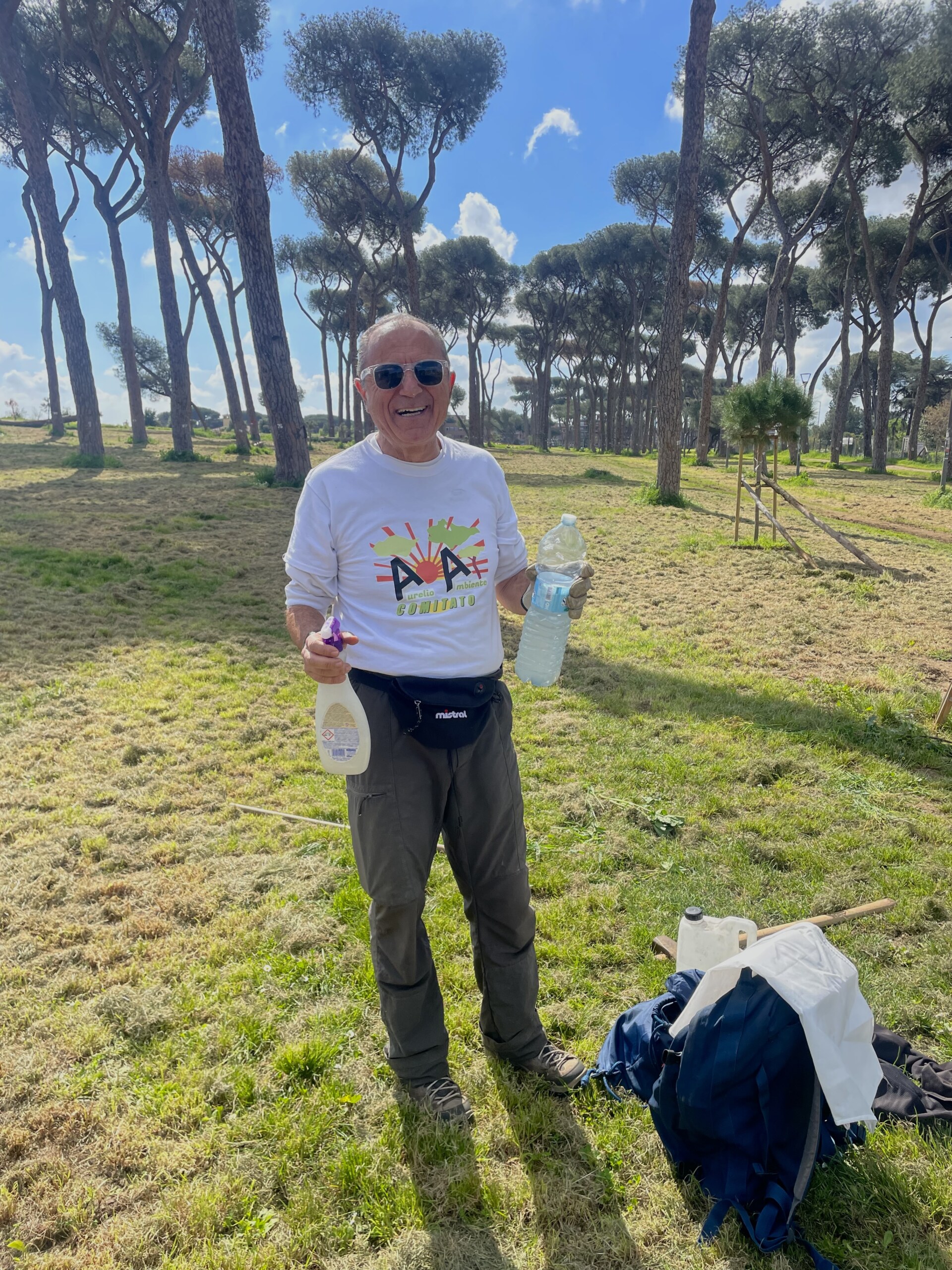
Franco Quaranta, president of the Comitato Aurelio per l’Ambiente, with his spray bottle of sapone di Marsiglia, garlic, and water; Photo by Elizabeth Djinis
Perhaps the logical next question is this: Where was the city of Rome in all of these events? The answer is, as always, complicated.
“Unfortunately, when the insect arrived, even if we knew that it was coming, we were not ready,” Sacerdote said. “So there was a time in which, at the regulatory level, it wasn’t possible yet to carry out treatments, because to do so, at least in Italy, the product has to be authorized for that very insect.”
The numbers, as it stands today, are as follows. Since November 2021, the city has taken down 13,281 trees, though Alfonsi notes first that 29,665 new trees were planted within that same time frame. Of the trees that were taken down, many were removed for “street clearances” or because of “disease or age, that they had arrived at the end of their cycle.”
In November 2024, the city conducted the first cycle of endotherapy treatments on all 50,000 pines in public areas, according to Alfonsi. She notes that one of her first actions in the environmental role was allocating 7 million euro towards a campaign to aid the trees. Roughly 100 million euro has been earmarked to care for the city’s vegetation between 2024 and 2026. These therapies, at least per the city, are working—about 90% of the treated trees have seen a reduced impact.
But residents like Jacopa Stinchelli, who founded the local activist group “Let’s defend the pines of Rome” and has become a public voice for the trees, are skeptical of the city’s efforts. In 2019, she and a collective of concerned citizens sent a letter to President Sergio Mattarella, noting that “If there is not some kind of immediate intervention, the majestic Italian pine, the undisputed and centuries-old icon of our landscape, is headed for extinction.”
In 2021, a ministerial decree was instituted outlining the methods needed to treat any affected pines. At that point, Stinchelli thought their work was done—emphasis on the word thought.
“You don’t talk in an emergency; you have to act, especially if you have a cure. But they talked a lot, and they started to say, ‘Well, we could go with other trees, and maybe we can’t cure them all. Maybe there isn’t enough money to cure thousands and thousands of trees,’” she said. “So there was some time that was lost in this debate, and we were baffled.”
The crux of the problem comes down to how the city decides which trees need to be cut down or pruned. Residents like Stinchelli and Quaranta say the companies hired by the city are working with little oversight—Stinchelli shows me her phone, full of WhatsApp messages from Romans lamenting the latest teardown of a tree or too-closely trimmed branches in their neighborhood.
Part of the issue is perhaps the conflating of pine trees affected by the parasite and pine trees in danger of actually falling, a valid fear in Rome. In December 2024, 45-year-old Francesca Ianni was killed by a falling tree in Livio Labor Park. Only a year prior, 82-year-old Teresa Veglianti was crushed by a tree that collapsed in Monteverde. It’s worth noting that in neither of these particular cases was the tree a pine.
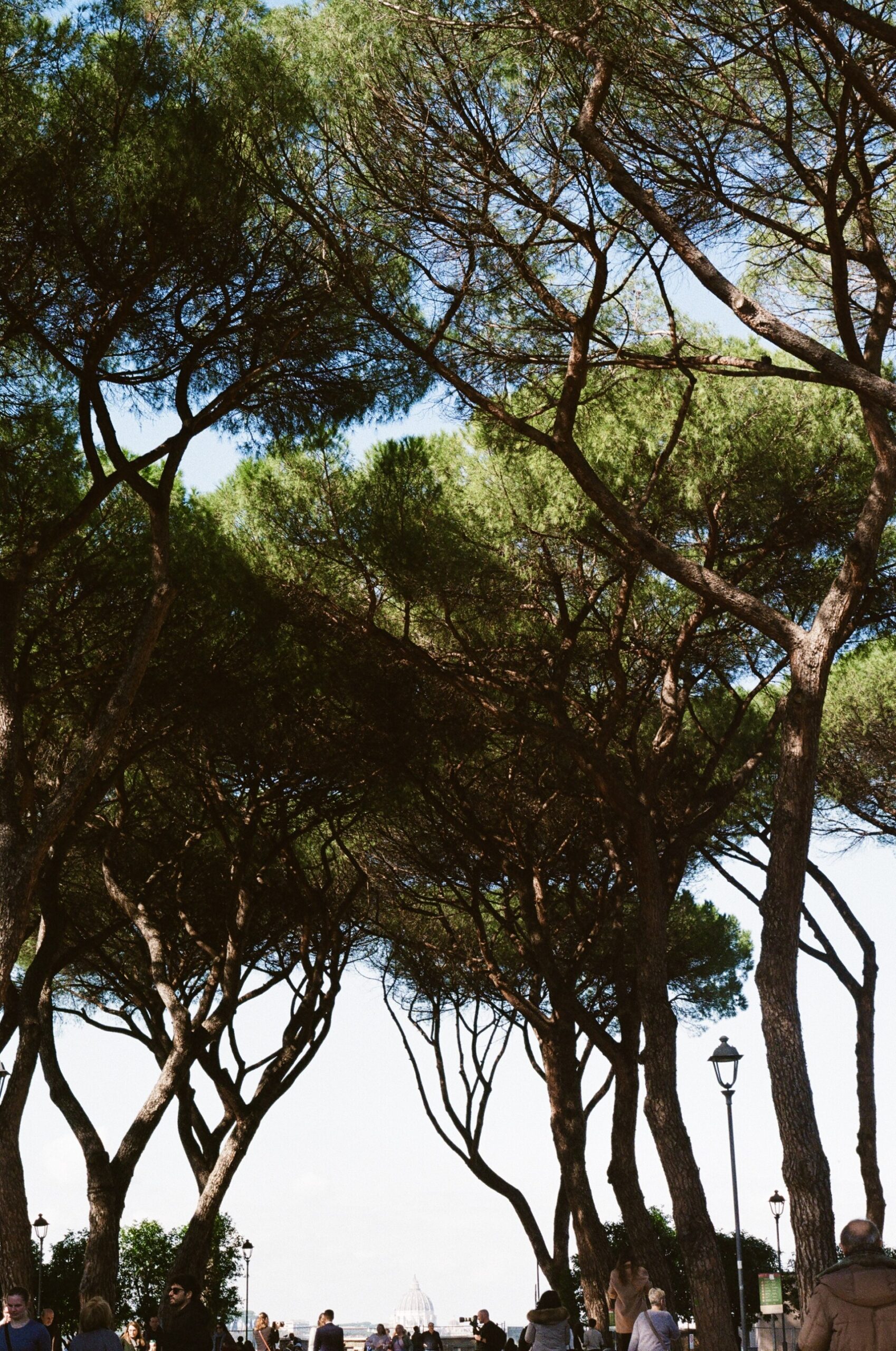
“When pine trees fall, it’s usually because of problems with the roots,” Sacerdote said. “Obviously, when the plant dies, the roots die, and it has to be removed. But it’s not that the presence of the pine tortoise scale itself causes a problem with its stability. To say that a pine tree is removed for safety reasons because it is affected by the pine tortoise scale is, in my opinion, a mistake.”
Other times, Sacerdote notes, it is simply a matter of convenience—while redoing a road, the company in charge may decide to just remove all of the trees rather than salvage what could remain.
“The people in charge of checking the trees are the same people who do the work,” Sacerdote said. “Instead, the people who carry out the checks should be independent, they should go there first and say: ‘Here, this is what must be done.’”
In Villa Pamphili, for example, the city announced its plan to cut down 51 pines and plant 160 new trees. But after pushback from the citizen group monitoring the park, which paid for its own agricultural study, the administration changed course and said that 32 of the 48 pines had responded well to treatment and only 16, in the end, would be cut down. Alfonsi later confirmed this assessment.
“As for when to cut a pine that is affected by the pine tortoise scale, it’s when the plant is dead or dying, when there are only a few years left,” Sacerdote said, “but if there are still some clumps of green at the top, there is still a chance, so what’s the problem?”
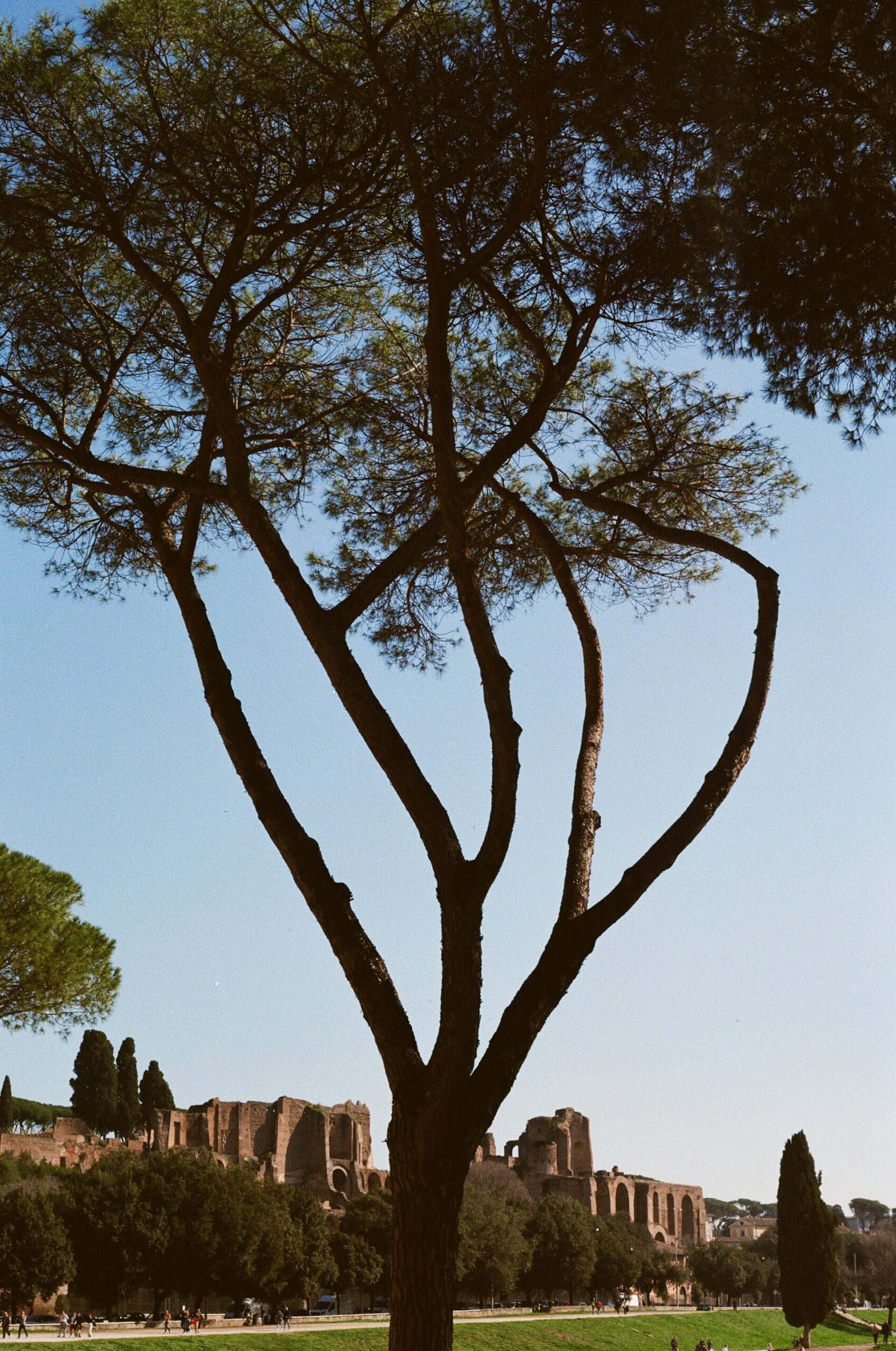
Yet the city maintains that it is, in fact, exercising the utmost caution in choosing which trees come down and which trees stay.
“The pines under the department’s jurisdiction will continue to be maintained and cared for, with the goal of conserving the current trees and going ahead with substitutions only in cases of dead or seriously ailing trees, integrating them with younger plants,” Alfonsi wrote in an email.
What residents like Stinchelli want is “transparency” and what she calls a “body count” of all the trees that have already gone.
“We have many requests, but actually, they are very simple,” Stinchelli said. “First of all, we want them to stop chopping and only to authorize it if experts certify it. We really want this on the table.”
The question, according to Sacerdote, comes down to how we envision the future of Rome’s landscape—with or without pine trees. If we can’t accept the latter, then, she said, there need to be strategies put in place to retain the pines we already have.
Both Stinchelli and Quaranta echo the same thought—the struggle for the pines is exhausting. Quaranta has been volunteering at Pineta Sachetti for eight summers. He sees the impact the group has had, and he also sees the worrying trend.
“The problem is that these trees keep dying,” he said. “So what will be left of this park?”
